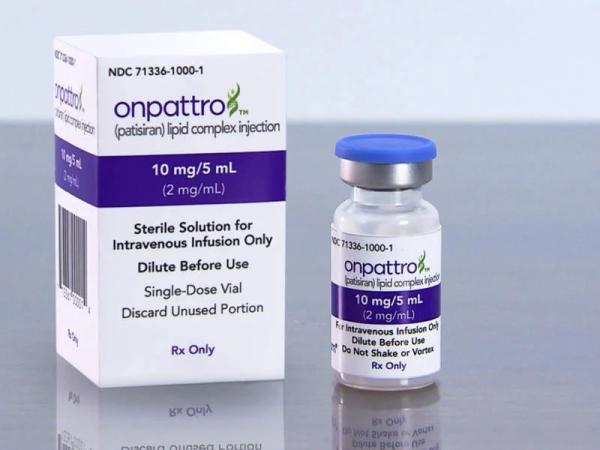Patisiran Side Effects
Medically reviewed by Drugs.com. Last updated on Aug 25, 2025.
Applies to patisiran: intravenous solution.
Precautions
It is very important that your doctor check your progress at regular visits to make sure that this medicine is working properly. Blood tests may be needed to check for unwanted effects.
This medicine may cause infusion-related reactions, which can be life-threatening and require immediate medical attention. Tell your doctor right away if you start to have a fever, chills or shaking, dizziness, trouble breathing, itching or rash, lightheadedness or fainting after receiving this medicine.
This medicine may lower the vitamin A levels in your body, which may cause eye or vision problems (eg, night blindness, blurred vision, difficulty with reading, or any other change in vision). Your doctor may want your eyes be checked by an ophthalmologist (eye doctor).
Serious side effects of patisiran
Along with its needed effects, patisiran may cause some unwanted effects. Although not all of these side effects may occur, if they do occur they may need medical attention.
Check with your doctor or nurse immediately if any of the following side effects occur while taking patisiran:
More common side effects
- back pain
- body aches or pain
- chest tightness
- chills
- cough
- difficulty in breathing
- ear congestion
- feeling of warmth
- fever
- headache
- loss of voice
- nasal congestion
- nausea
- redness of the face, neck, arms, and occasionally, upper chest
- runny nose
- sneezing
- sore throat
- unusual tiredness or weakness
- vomiting
Less common side effects
- blurred vision
- chest pain
- cough producing mucus
- dizziness
- dry eye
- fainting
- pounding, slow heartbeat
- seeing floating dark spots or material before the eyes
Rare side effects
- blistering, crusting, irritation, itching, or reddening of the skin burning, pain, redness, or swelling at the injection site
- changes in skin color, pain, tenderness, or swelling of the foot or leg
- cracked, dry, scaly skin
Other side effects of patisiran
Some side effects of patisiran may occur that usually do not need medical attention. These side effects may go away during treatment as your body adjusts to the medicine. Also, your health care professional may be able to tell you about ways to prevent or reduce some of these side effects.
Check with your health care professional if any of the following side effects continue or are bothersome or if you have any questions about them:
Less common side effects
- belching
- feeling of constant movement of self or surroundings
- heartburn
- indigestion
- muscle spasms
- sensation of spinning
- stomach discomfort, upset, or pain
See also:
For healthcare professionals
Applies to patisiran: intravenous solution.
General adverse events
The most common adverse reactions were upper respiratory tract infections, infusion-related reactions and peripheral edema.[Ref]
Cardiovascular
- Common (1% to 10%): Atrioventricular (AV) heart block[Ref]
There were 3.7% of patients with atrioventricular heart block, of which three cases were complete AV block.[Ref]
Respiratory
- Very common (10% or more): Upper respiratory infection (29%)
- Common (1% to 10%): Dyspnea, bronchitis[Ref]
Upper respiratory infections included nasopharyngitis, upper respiratory tract infection, respiratory tract infection, pharyngitis, rhinitis, sinusitis, viral upper respiratory tract infection, and upper respiratory tract congestion.[Ref]
Ocular
- Common (1% to 10%): Dry eye, blurred vision, vitreous floaters[Ref]
Musculoskeletal
- Common (1% to 10%): Muscle spasms, arthralgia[Ref]
Other
Dermatologic
Gastrointestinal
Immunologic
- Very common (10% or more): Infusion-related reactions (up to 19%)
- Common (1% to 10%): Antibody formation[Ref]
Among patients who experienced infusion-related reactions (IRR), up to 79% occurred within the first two infusions and the frequency decreased over time. IRR led to infusion interruption in 5% of patients and resulted in permanent discontinuation in less than 1%.
There was no evidence that anti-drug antibodies influenced the clinical efficacy, safety, pharmacokinetic or pharmacodynamic profiles of this drug; however, the data are limited.[Ref]
Local
- Very common (10% or more): Peripheral edema (29.7%)
- Uncommon (0.1% to 1%): Extravasation[Ref]
In all cases of peripheral edema, the severity was mild to moderate, and did not result in treatment discontinuation.[Ref]
References
1. (2022) "Product Information. Onpattro (patisiran)." Alnylam Australia Pty Ltd
2. (2023) "Product Information. Onpattro (patisiran)." Alnylam Pharmaceuticals, SUPPL-12
3. (2022) "Product Information. Onpattro (patisiran)." Alnylam UK Ltd
Frequently asked questions
- Onpattro vs Tegsedi - how do they compare?
- How does Onpattro (patisiran) work?
- What type of drug is Onpattro?
More about patisiran
- Compare alternatives
- Dosage information
- During pregnancy
- Drug class: miscellaneous metabolic agents
- En español
Patient resources
Other brands
Professional resources
Other brands
Related treatment guides
Further information
Patisiran side effects can vary depending on the individual. Always consult your healthcare provider to ensure the information displayed on this page applies to your personal circumstances.
Note: Medication side effects may be underreported. If you are experiencing side effects that are not listed, submit a report to the FDA by following this guide.

